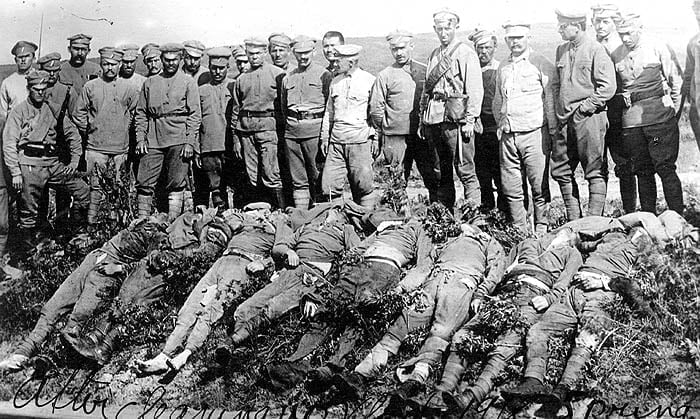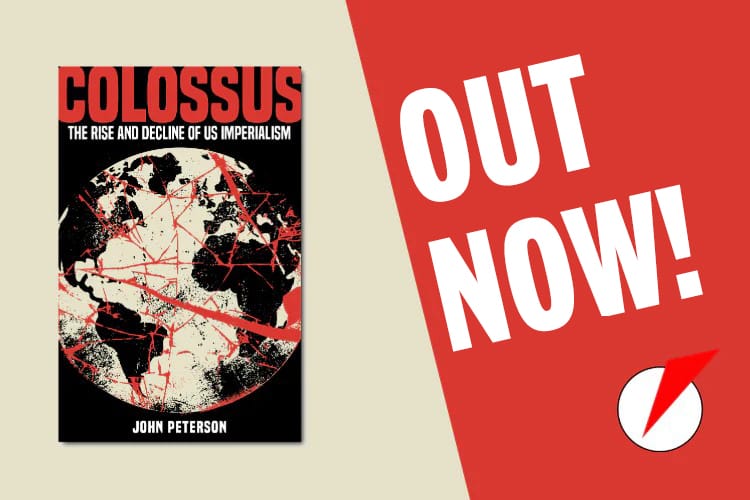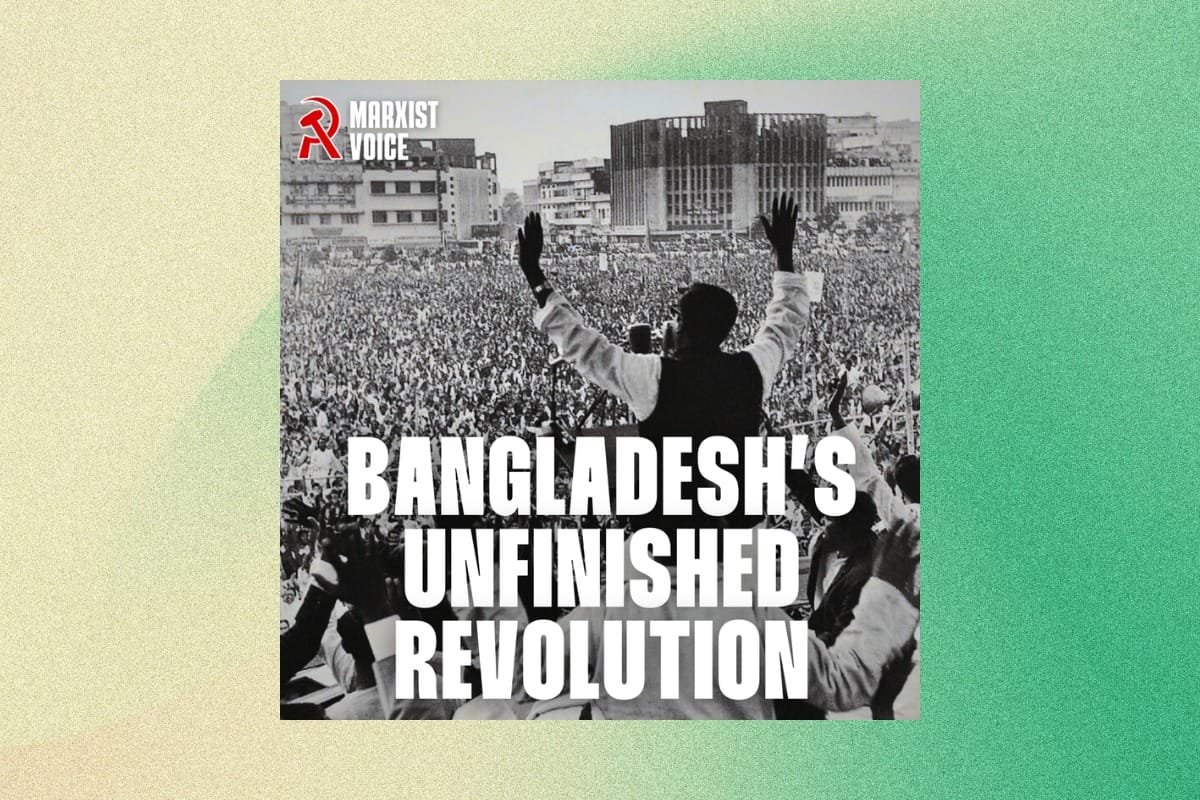In this year of the centenary of the 1917 Russian Revolution, we are witnessing a barrage of propaganda against Lenin and the Bolsheviks. The same critics, however, as Fred Weston explains, conveniently put to one side the long history of brutal suppression of workers’ revolutions carried out by the class they themselves serve.
The barrage of propaganda against Lenin and the Bolsheviks has begun. This year, the 100th anniversary of the Russian Revolution, we will see learned critics working to turn public opinion against the Bolsheviks and what they stood for, in an attempt to bury the truth about what the revolution was really about. The same critics conveniently put to one side the long history of brutal suppression of workers’ revolutions carried out by the class they themselves serve.
In the first of a four-part series about the horrific crimes committed by the capitalist class, Fred Weston examines a small sample of the violent, brutal, and bloody episodes from the history of capitalism – including the Paris Commune, the massacre of the Chinese Communists, and the White Terror unleashed against Russian workers and peasants.
The violent rise of the bourgeoisie
Marx wrote that “…capital comes dripping from head to foot, from every pore, with blood and dirt.” (Capital, Volume One, Chapter Thirty-One: Genesis of the Industrial Capitalist). He was describing the ruthless methods used by the rising bourgeoisie to grab resources and accumulate capital, causing terrible suffering and death in the process.
The bourgeoisie also does not like to be reminded that it came to power through bloody revolution, not through gradual reform. When the old ruling classes, the feudal, landed aristocracies, refused to go, revolution was the only way of moving society forward. But then revolution was in the interests of the rising bourgeoisie.
In the historical bourgeois revolutions, the English Civil War, as it is known – in reality the English Revolution of 1642–1651 – or the famous French Revolution of 1789, we see that the bourgeoisie in order to establish its rule resorted to violent revolution with much bloodshed and death involved. Although we may read articles about these events lamenting this “unfortunate” violence, we do not see the same condemnations that are heaped on the Russian Revolution.
Why is that? The answer is very simple. The English and French revolutions brought to power the bourgeoisie, the same class that rules today. They broke the chains of the old feudal system that was holding back the development of capitalism, a system that was in embryonic form, and laid the basis for an enormous development of the productive forces, of science and technique. With this also came new rights, bourgeois rights of course, but nonetheless an advance on what prevailed under feudalism.
In 1989 in France – and internationally – there were lavish celebrations on the 200th anniversary of the French revolution. Of course, the celebrations ignored the real meaning of 1789. That was more to do with the fear of revolution today. Nonetheless, the event was celebrated, in spite of all the violence, death and bloodshed.
Not so when it comes to the Russian Revolution. And the reason is clear: the Russian Revolution put an end to capitalism and landlordism, it removed from power the hated Tsarist regime and began the process of building a workers’ state. That is the reason why they hate it so much – it gave an example to the workers of the world, an example they could look to and emulate, as mass Communist Parties emerged in many countries and revolution reverberated around the world, from the German Revolution of November 1918 right through to the Spanish Revolution of 1931-37.
It is precisely because Lenin and the Bolsheviks demonstrated that a workers’ revolution was possible, that the workers could come to power and begin the process of transforming society, that so much attention is dedicated to distorting historical truth. It has nothing to do with the use of violence. This is merely used to depict an image of a bloodthirsty, crazed Lenin, a picture that can be used as a scarecrow whenever the question of social revolution is raised as a necessary means of achieving real change in society. It is to frighten radicalised youth and workers away from the Communists, the Marxists.
The White Terror
The Russian Revolution of October 1917 was actually a relatively peaceful event, peaceful in the sense of very few deaths occurring. In the main cities, so overwhelming was the support the Bolsheviks had won by then, that the old regime simply crumbled and offered very little organised resistance. The violence came after the revolution, as it was quickly transformed into Civil War because the old exploiters, the Tsarist landed aristocracy and the capitalists refused to accept the will of the people, which involved the expropriation of the landlords and capitalists. Thus they launched a war against Soviet power. The Bolsheviks had to fight back with everything they had to keep alive the fledgling workers’ state.
The truth is that if the October Revolution had not taken place, the revolutionary workers, peasants and soldiers would have been drowned in blood. Towards the end of August and early September 1917, General Kornilov had amassed his troops in the vicinity of Petrograd. He had prepared his so-called “Savage Division”, experienced fighters from the Caucasus, to enter the city and drown the revolution in blood.
His aim was not to defend “democracy” but to establish a military dictatorship to restore the old order. As the historian Mayer states in his book, The Furies: Violence and Terror in the French and Russian Revolutions (Princeton, NJ: Princeton University Press, 2001): “Bent on restoring the old regime and empire, even if stripped of the Romanov dynasty, the latter [tsarist officers] were as hostile to liberal or socialist democracy as they were to proletarian dictatorship.”
According to some historians, Kornilov ordered that no captives should be taken and even the injured should not be rescued from the battlefields. His defeat at the hands of the Petrograd workers, led by the Bolsheviks, saved the Russian masses from a particularly vicious dictatorship, which would have been a Russian version of fascism.
The White Terror that ensued during the Civil War led to hundreds of thousands of men, women and children being killed, with summary executions of peasants who supported the Bolsheviks. Mayer reports of Kornilov’s threat, after escaping from prison, “the greater the terror, the greater our victories.” While he was gathering his forces – before the Red Army was formed – for an all-out counter-revolutionary war, he vowed that his goals must be fulfilled even if it meant “to set fire to half the country and shed the blood of three-quarters of all Russians.” Kornilov also promoted anti-Semitic pogroms in an attempt to bring back the old pre-revolutionary filth of the Tsarist regime.
When we say that he wanted the old regime, let us not forget what that regime was. In January 1905 there was the event that went down in history as “Bloody Sunday” [9th January]. A peaceful demonstration of around 140,000 people had gathered outside the Winter Palace to petition the Tsar. The response they received was to be a bitter lesson in the true nature of the Tsar and his regime. Troops opened fire on the unarmed masses, killing hundreds and wounding thousands. That is when the Tsar became known as “Nicholas the Bloody”.
It is this history that explains the hatred of the Russian masses towards the Tsarist regime. And as Lenin wrote from exile in Switzerland at the time, “The working class has received a momentous lesson in civil war: the revolutionary education of the proletariat made more progress in one day than it could have made in months and years of drab, humdrum, wretched existence. The slogan of the heroic St Petersburg proletariat, ‘Death or Freedom!’ is reverberating throughout Russia.”
Had Kornilov been victorious in the Civil War there would have been a far worse “Bloody Sunday”. And what would the bourgeois historians be saying now? No doubt, they would be justifying it as a necessary means of maintaining the established order and little would be said of the “violence and bloodshed”! The reason for that is that it would have been blood spilled in the defence of private property, of the privileges of the elite, of their right to exploit the workers and peasants and to continue the centuries-long suffering of the poor working masses.
Slanderous campaign against Lenin
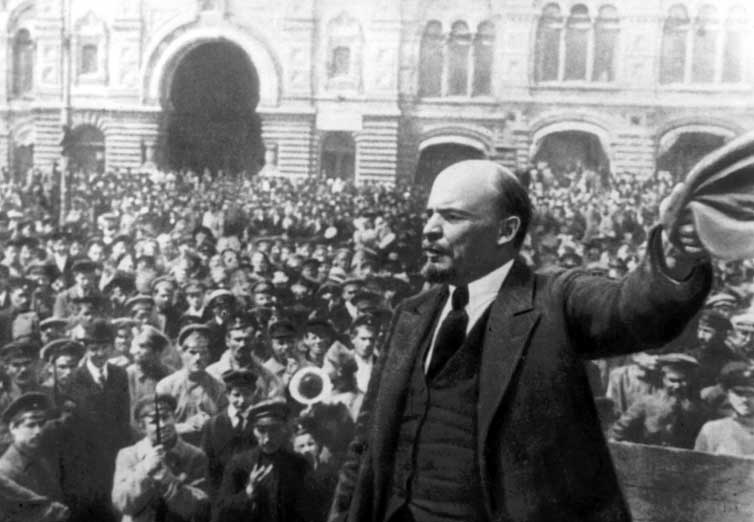 The Russian Revolution was successful because a party of Marxist cadres had been built beforehand, the Bolshevik Party. Such a party would not have existed if it had not been for Lenin struggling over many years for theoretical clarity, for the basic ideas of Marxism within the young Russian labour movement.
The Russian Revolution was successful because a party of Marxist cadres had been built beforehand, the Bolshevik Party. Such a party would not have existed if it had not been for Lenin struggling over many years for theoretical clarity, for the basic ideas of Marxism within the young Russian labour movement.
This is not the place to outline the history of the building of the party, but if anyone wishes to deepen their understanding on this question, read Bolshevism – The Road to Revolution by Alan Woods and Lenin’s What Is To Be Done? Lenin struggled all his adult life for the cause of the working class and to put an end to the tyranny of the Tsarist regime. His contribution to Marxism is unquestionable and his writings are a treasure trove of Marxist theory.
It is this that the bourgeoisie for the past one hundred years has wanted to bury under a heap of lies and distortions. This kind of propaganda has nothing to do with establishing historical truth and all to do with a struggle between the classes over the future of the society we live in. The kind of propaganda we can expect to see this year is already easily available.
One example is the 1997 Discovery Channel documentary, in which we see Professor Robert Service attempting to analyse the Russian Revolution by psychoanalysing Lenin. He adds a novel idea, that it was Lenin’s fading health that caused him to become impatient and this had direct consequences on how the Russian Revolution unfolded. The ridiculous idea presented here is that Lenin pushed for the party to decide the day of the insurrection, not because it was an objective necessity otherwise the generals would have taken power, but because he was in a hurry “to cram into his revolutionary career as much as possible” so as to see revolution before he died!
We are also told about Lenin’s supposed “violent mood swings”, his putting an end to anything, even listening to music he liked, so that he would not be distracted from revolution. The documentary goes into a lot of personal detail. It is all designed to present Lenin as some kind of psychopath.
However, even this documentary designed to dirty the name of Lenin and the revolution, towards the end cannot avoid showing the immense support that Lenin had among the worker and peasant masses. This is something bourgeois professors cannot relate to, as they are incapable of seeing the world through the eyes of the downtrodden workers and peasants under the Tsarist regime; they cannot understand the immense class hatred that existed in the depths of society.
In another video, Vladimir Lenin documentary – Stunning Documentaries, we have Nina Tumarkin, professor of history at Wellesley College, attempting to analyse Lenin as a child. She describes him as “one of those bossy kids”…, “self-centred…”, but also a “competent and smart child”. The idea, again, is to present an almost inhuman Lenin with the potential to be a “dictator” because he was supposedly a “bossy kid”!
It would require a book to respond to all the slanders against Lenin. We will deal with all this in a series of articles and videos we will publish throughout 2017. Here we will concentrate on the violence of the capitalist class and the brutal methods it has used throughout history to crush worker and peasant revolts.
The Russian Revolution was different from all the other attempted revolutions in one thing: it succeeded where all others failed. And when those revolutions failed, the response of the bourgeoisie was violent to the extreme. When it comes to defending its vital interests, its political system, its profits and privileges, its spheres of influence and its markets, the bourgeoisie is prepared to use any means necessary, as this article will demonstrate.
Churchill determined to use chemical weapons in war against the Bolsheviks
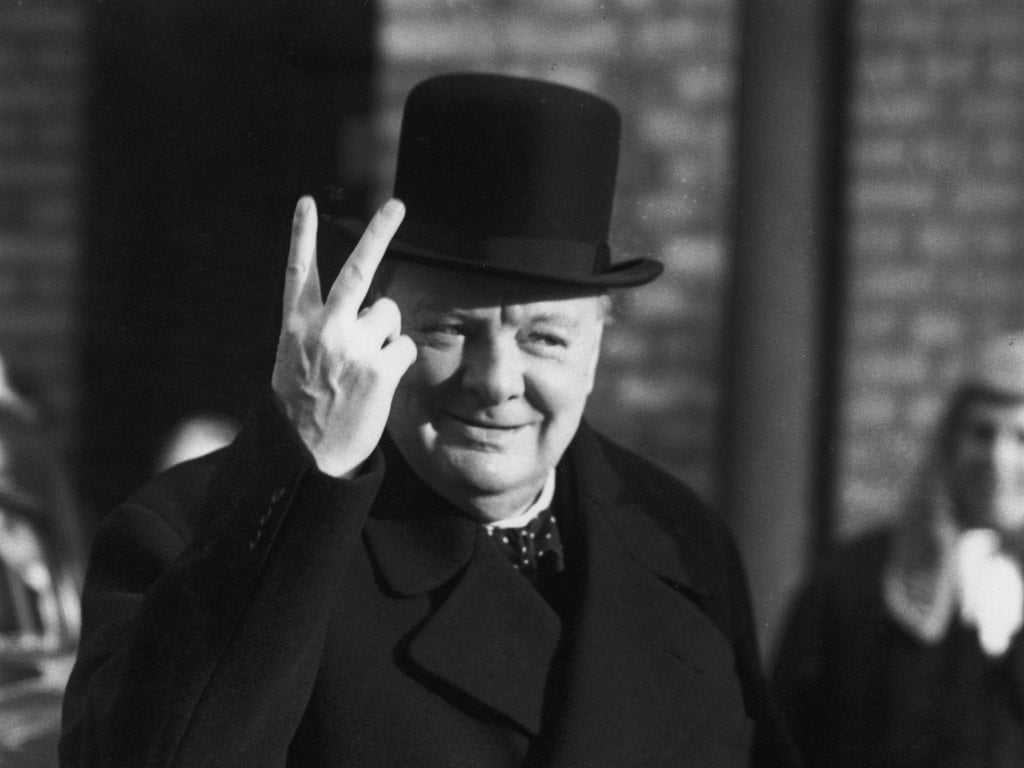 What the mainstream bourgeois historians cannot really admit is that the Russian Revolution succeeded because it had mass support of the workers and peasants. During the civil war that ensued, as the Red Army advanced the land was taken from the landlords and distributed to the peasants. Whenever the White Army took areas, these progressive measures were reversed. That explains why the Red Army advanced in the face of armies that were armed and backed by powerful imperialist countries.
What the mainstream bourgeois historians cannot really admit is that the Russian Revolution succeeded because it had mass support of the workers and peasants. During the civil war that ensued, as the Red Army advanced the land was taken from the landlords and distributed to the peasants. Whenever the White Army took areas, these progressive measures were reversed. That explains why the Red Army advanced in the face of armies that were armed and backed by powerful imperialist countries.
In desperation Churchill ordered the use of chemical weapons against the Bolsheviks. An article that appeared in The Guardian in September 2013, Winston Churchill’s shocking use of chemical weapons, explains what happened in 1919: “As a long-term advocate of chemical warfare, he was determined to use them against the Russian Bolsheviks. In the summer of 1919… Churchill planned and executed a sustained chemical attack on northern Russia.”
A new chemical weapon had been developed, the secret “M Device”, capable of delivering a very toxic gas, diphenylaminechloroarsine. The officer in charge of the project, Major General Charles Foulkes, described it as “the most effective chemical weapon ever devised”. It caused uncontrollable vomiting, the coughing up of blood and collapse of the victims.
Sir Keith Price, head of chemical warfare production, was convinced it would lead very quickly to the collapse of Bolshevik power in the Soviet Union. At the end of August 1919, several Bolshevik-held villages were bombed, but the weapon proved less effective than Churchill had hoped and very soon its use was brought to an end.
But let us just reflect for a moment. Here we have a British political leader – hailed as a democrat by the same historians who are condemning the violence of the Red Army – who was prepared to use chemical weapons indiscriminately on Russian peasant villages. Again, the contrast is stark to the nth degree. Had the Red Army used such methods they would be shouting about it from the rooftops. But of course, they didn’t!
The massacre of the Paris Commune
 If any readers are not convinced that the White Terror would have led to a bloody massacre of the revolution, it is worth looking at what happened to the courageous Communards during the short-lived Paris Commune back in 1871. How many school students are ever taught about what happened in Paris in the months of March, April and May of that year? To pose the question is enough to know what the answer will be. At best it is mentioned as a minor detail in the aftermath of the defeat of Emperor Napoleon III in September 1870 in the Franco-Prussian War.
If any readers are not convinced that the White Terror would have led to a bloody massacre of the revolution, it is worth looking at what happened to the courageous Communards during the short-lived Paris Commune back in 1871. How many school students are ever taught about what happened in Paris in the months of March, April and May of that year? To pose the question is enough to know what the answer will be. At best it is mentioned as a minor detail in the aftermath of the defeat of Emperor Napoleon III in September 1870 in the Franco-Prussian War.
In reality the Paris Commune was the first time in history that workers had consciously attempted to take over the running of society. If anyone wants to read more on this glorious episode in working class history, they can read Marx’s The Civil War in France, Lenin on the Paris Commune, Lessons of the Commune, and for a detailed account of the events there is Lissagaray’s History of the Paris Commune of 1871.
Once the reactionary troops of the Versailles regime managed to enter Paris, a systematic butchering of Communards began, and according to different sources anything between 18,000 and 20,000 Communards were executed during the Semaine Sanglante (“Bloody Week”), and thousands more were either jailed or went into exile to escape the repression.
Just to give a small idea of what went on in those terrible days for the Parisian working class, it is sufficient to quote one passage from Merriman’s “Massacre: the life and death of the Paris Commune of 1871” (2014):
“Social class could determine life or death. Middle-class Communards were more likely to talk their way out of encounters with Versaillais. Sutter-Laumann survived because he washed carefully, combed his hair, and spoke ‘without a working-class accent in good French’ when stopped by an officer of the Volunteers of the Seine. If those who were stopped spoke the argot of the Parisian street and workplace, execution usually followed. An officer interrogated a man at a barricade on rue Houdon: ‘Who are you?’ ‘A mason’, the man replied. ‘So, now it’s masons who are going to command!’ The officer shot the man dead on the spot. Social stigmatisation led to massacre.”
There are many more passages like this, which show the real face of the French bourgeoisie when faced with the threat of social revolution that could have taken away all their privileges and put an end to their oppressive rule. In their minds such levels of violence were justified. Here again we see that it is not violence per se that is the key element in judging whether it was justified, but the fact that it was used to defend the existing order.
The 1916 Irish Easter Rising
 Irish history over the centuries was one of a nation oppressed by British imperialism, with the Irish people treated almost like pack animals, crushed and humiliated by a foreign oppressor propertied class, brutally treated in the name of profit and privilege. The most striking example of this was the Great Famine (1845-52), when around a million poor Irish starved to death and a further million were forced to emigrate. As a result the island lost about one quarter of its population.
Irish history over the centuries was one of a nation oppressed by British imperialism, with the Irish people treated almost like pack animals, crushed and humiliated by a foreign oppressor propertied class, brutally treated in the name of profit and privilege. The most striking example of this was the Great Famine (1845-52), when around a million poor Irish starved to death and a further million were forced to emigrate. As a result the island lost about one quarter of its population.
We are told in the history books that it was the potato blight, a disease that destroyed the potato crop, that caused this widespread hunger. But this is only a very small part of the truth. The potato blight affected many other countries in the same period across Europe, but it is estimated that only around 100,000 died as a result. So why did so many die in Ireland alone?
One would think that if there was a failure of the potato crop, the Irish peasants could have eaten other crops. In fact, according to many historians, Ireland produced enough other crops and livestock to feed its population. According to Cecil Woodham-Smith, in his work The Great Hunger; Ireland 1845-1849, “Although the potato crop failed, the country was still producing and exporting more than enough grain crops to feed the population. But that was a ‘money crop’ and not a ‘food crop’ and could not be interfered with.” [My emphasis] Ireland’s agricultural production at the time could have fed around eighteen million people, double the then population of the country. For every ship loaded with food produce going into Ireland there were six coming out. This extraction of Ireland’s agricultural produce from the island during the famine was ensured by the British army who guarded and suppressed any attempt by the starving Irish masses to get their hands on the “money crop”.
Ladies and gentlemen, wearing the latest fashions of the time, eating the best food and drinking the best wine, living in the wealthy quarters of London and other British cities were responsible for the death of a million Irish people. They allowed all this to happen rather than renounce on some of their profits. It was cold blooded murder, but we see no analysis of bloodthirsty psychopaths here, no condemnation, no big media campaigns to expose this historical crime. Of course not, as the people responsible for this crime against humanity were the forebears of today’s ruling class, who continue to defend the system that is capable of such inhumane behaviour.
The death of so many left a mark on the consciousness of the Irish, who had already many times before shown signs of a brewing rebellion deep down in the oppressed layers of society. This was eventually to lead to the armed rebellion of the Easter Rising of 1916 and independence from the yoke of British imperialism, after the War of Independence of 1919-21. This is not the place to go into the reasons as to why Ireland did not achieve full independence and why British imperialism managed to hold on to the six counties in the north. (For a detailed analysis see Alan Woods’ Ireland: Republicanism and Revolution.) For the purposes of this article it is worth simply concentrating on how the leaders of the Easter Rising were dealt with by the British.
The casualties involved in the Rising were close to 500 with over 2600 wounded, mostly civilians. The British forces during the rebellion used artillery, incendiary shells and heavy machine guns in built-up areas, putting at risk the lives of the local population. At the same time they revealed an “inability to discern rebels from civilians”. One Royal Irish Regiment officer recalled, “they regarded, not unreasonably, everyone they saw as an enemy, and fired at anything that moved”.
The Easter Rising was a courageous stand, but in the given circumstances it was doomed to failure. However, it was to shake the consciousness of the Irish masses, who within a few years would rise against British imperialism. The savagery of the British in dealing with the leaders played a big role in this.
After a farcical trial, sixteen leaders were condemned to death by firing squad. Every day for a few days the executions were carried out. The case of James Connolly stands out, for he was badly wounded and could not stand. He had shrapnel in his chest and his ankle had been shattered. He was carried on a stretcher from the ambulance to the courtyard where he was to be shot. According to some witnesses he attempted to stand, defiant to the very end, but slumped and overbalanced. So they strapped him to a stretcher and placed him in a reclining position tied to a chair in order to shoot him.
This was how the British bourgeoisie dealt with the leaders of the easter Rising who had dared to challenge their right to rule over Ireland, their “first colony”. There was no humanitarian liberalism here; just cold-blooded revenge, with the aim of “giving the Irish a lesson”.
The rise of Italian Fascism
 While Russia was in full revolution, there were other movements that threatened the power of the ruling classes in other countries. One of these was in Italy, where in Turin in August 1917 bread riots led by working class women erupted that quickly grew into generalised working class anti-war protests with armed conflicts between workers and state forces. The movement was eventually put down violently, with many workers killed. According to bourgeois sources at least 50 were killed and 200 were wounded, and 822 workers were arrested. Other sources say the deaths could have been as much as 500, as the bodies were very quickly carted away as the authorities attempted to stop news of the event from spreading.
While Russia was in full revolution, there were other movements that threatened the power of the ruling classes in other countries. One of these was in Italy, where in Turin in August 1917 bread riots led by working class women erupted that quickly grew into generalised working class anti-war protests with armed conflicts between workers and state forces. The movement was eventually put down violently, with many workers killed. According to bourgeois sources at least 50 were killed and 200 were wounded, and 822 workers were arrested. Other sources say the deaths could have been as much as 500, as the bodies were very quickly carted away as the authorities attempted to stop news of the event from spreading.
This was merely a harbinger of what was to come. But it was not the first time that the Italian state authorities had fired on and killed protesting workers. There was a long history of violent state repression of worker protests. One of the most famous took place back in 1898 the “Bava-Beccaris massacre”, named after the General who ordered the shootings of workers during widespread food riots in Milan. On May 7, 1898, 60,000 striking workers started marching towards the centre of Milan. General Bava-Beccaris positioned his troops in Piazza del Duomo, the main central square of Milan. As the workers advanced, the General issued the order to fire on the demonstrators, including the use of artillery. Eighty demonstrators were killed and 450 were wounded, according to official statements.
In the aftermath of the First World War in Italy there was a huge wave of worker and peasant struggles. Land occupations were widespread in the south, while in the industrial centres, mainly in the north but not only, the movement culminated in the famous Factory Occupations of September 1920. (See Italy September 1920: The Occupation of the Factories: The Lost Revolution).
This was the Italian Revolution – the culmination of a process that went back decades – and it had put the fear of God into the capitalists and landlords. Once the immediate threat of revolution had passed, the bourgeoisie hit back with a vengeance. Not satisfied with having defeated the movement – see article quoted above for the reasons of this defeat – they backed and financed Mussolini’s Fascists, using them as shock troops against the revolutionary workers.
Mussolini had founded his Fascist Party in 1919, and initially he had only small forces gathered around him. But the defeat of the working class in 1920 prepared the ground for his rise. Suddenly money from wealthy capitalists started raining on Mussolini’s party while the state repressive apparatus turned a blind eye and even supported logistically the raids by fascist death squads against trade unions and socialist organisations and socialist led local authorities. At the peak of this terrorist offensive, in 1922 he organised the famous “march on Rome” when the King appointed him as Prime Minister. The dictatorship was declared later, in 1926.
What fascism meant for the working class
In April 1926 the trade unions were replaced by the Fascist “corporations” under the direct control of the regime. The right to strike was abolished. This was the answer to the revolutionary movement of 1918-20 during which the workers had won important wage increases and the eight hour day. In May 1927 a 10 percent wage cut was imposed followed in October of the same year by further cut, leading to an overall annual reduction in wages of 20 percent. In 1930 the bosses’ association, Confindustria, requested a further lowering of labour costs and the regime imposed another 8 percent cut in wages, and another in 1934. And although, faced with high inflation in the mid to late 1930s, the regime was forced to grant some wage increases, the overall cut in real wages for workers between 1922 and 1943 was 25 percent.
In the process of consolidating their grip on power, the Fascist death squads organised a systematic campaign of burning Communist Party, Socialist Party and Trade Union offices, attacking labour movement meetings and assassinating key worker and peasant leaders. According to Gaetano Salvemini, in his book “Le origini del fascismo in Italia” [The Origins of Fascism in Italy, Feltrinelli, 1979] “About three thousand people lost their lives at the hands of fascists during the two years of civil war”.
The most famous case was that of Giacomo Matteotti, a Socialist Party MP who publicly denounced the 1924 elections as a sham, accusing the government of vote-rigging and fraud. He was assassinated on 10 June of that year. The assassins acted on the direct orders of Mussolini himself, who was by then already the prime minister.
According to Giorgio Candeloro in his classic History of Modern Italy, in the first six months of 1921, overall there were 726 cases of Fascist squads ransacking and destroying offices, party branches and printing presses, including 119 Trade Union headquarters and 141 Communist and Socialist Party branches.
The treatment of Antonio Gramsci
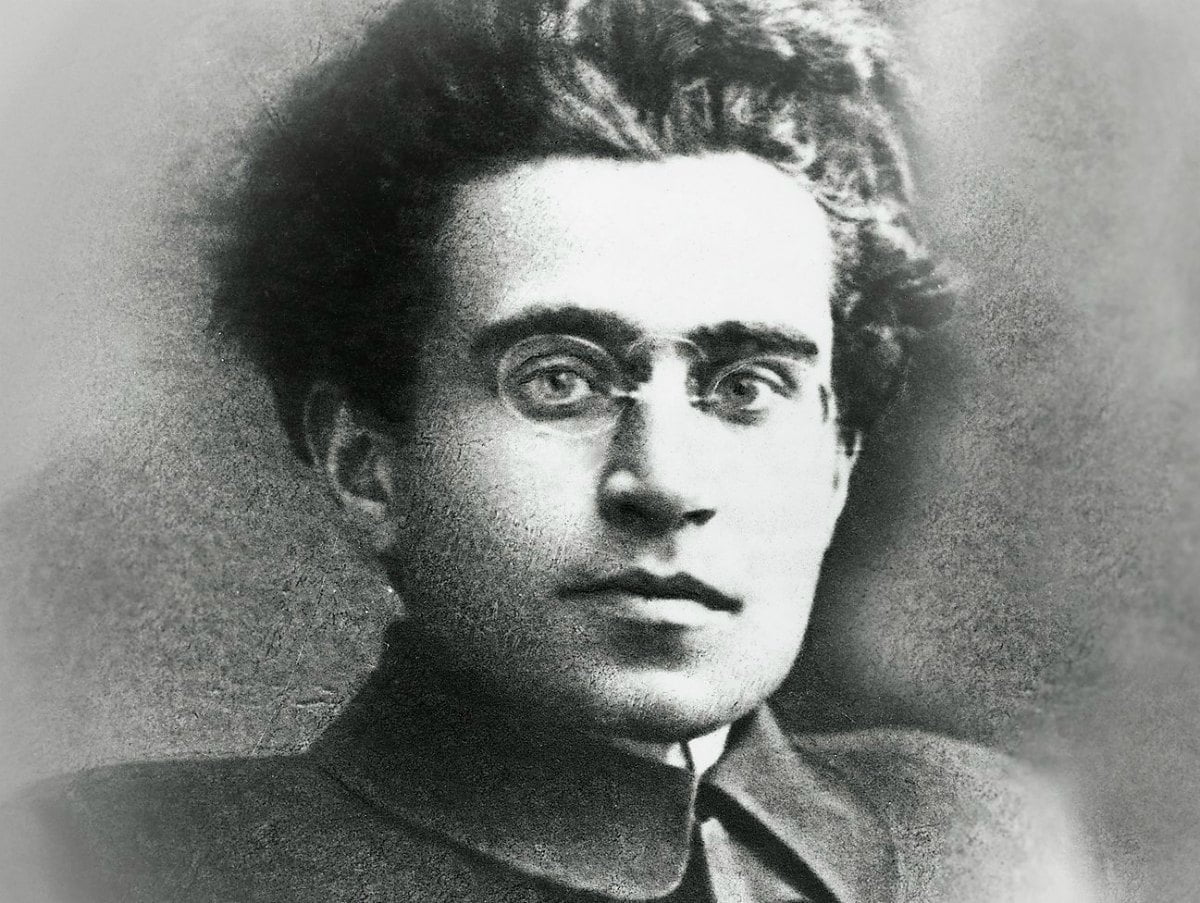 The Communists – together with the Socialists – were in fact those who the regime was particularly interested in crushing. In November 1926 Mussolini moved to destroy the last vestiges of bourgeois parliamentary democracy. On November 8, Antonio Gramsci, the leader of the Italian Communist Party and a Member of Parliament, was arrested. He was eventually put on “trial” in May 1928. During the proceedings the Prosecutor made it very clear why Gramsci was in prison when he said, “We must prevent this brain from functioning for twenty years.” In fact, he was given a twenty year prison sentence!
The Communists – together with the Socialists – were in fact those who the regime was particularly interested in crushing. In November 1926 Mussolini moved to destroy the last vestiges of bourgeois parliamentary democracy. On November 8, Antonio Gramsci, the leader of the Italian Communist Party and a Member of Parliament, was arrested. He was eventually put on “trial” in May 1928. During the proceedings the Prosecutor made it very clear why Gramsci was in prison when he said, “We must prevent this brain from functioning for twenty years.” In fact, he was given a twenty year prison sentence!
Gramsci was of a weak constitution, with many health problems. He was sent to serve his sentence in a prison in Turi, near Bari in the South. The journey took twelve gruelling days, with Gramsci tied in chains. He arrived ill, as a fellow prisoner described his condition, “his digestive system was completely upset, he was breathing with great difficulty, and unable to walk more than a step at a time without leaning on someone.” The doctor provided by the regime told Gramsci that “as a good fascist” he would like nothing better than to see him dead. In prison Gramsci’s health deteriorated rapidly. He started coughing up blood and was in effect slowly dying. His only chance of survival would have been to be released from prison and to live in better conditions. Eventually, after years of ordeal, he was allowed to move to a clinic south of Rome, but under heavy police surveillance. But the move was too late and on 27 April 1937 he died. Mussolini had achieved his goal, not just silencing Gramsci for twenty years but forever.
After the initial phase of the consolidation of the Fascist regime, after having killing 3000 socialist and communist workers, the regime resorted to a relatively small number of executions. According to figures provided by ANPI (National Association of Italian Partisans), 42 dissidents were shot after being sentenced by the Fascist Special Tribunal after 1926. In this period, the regime used prison and internal exile against the anti-fascists, affecting thousands of people and dislocating the structures of the anti-fascist parties. A total of 28,000 years of imprisonment was meted out to anti-fascist dissidents.
It was in 1938, with the introduction of the Racial Laws in November of that year, that mass killings were once again being prepared. These laws were introduced specifically against Jews as a gesture to Hitler. Thus, during the Second World War, began the internment and deportation of Jews to the Nazi death camps on a large scale. 45,000 were deported to Germany to the concentration camps, 15,000 of whom never returned, mostly Jews, but also political oppositionists.
After the military coup that deposed Mussolini, the Fascist regime was reconstituted under German occupation, known as the “Repubblica di Salo’”. This regime, in collaboration with the Nazis, carried out terrible torture and killings in its war against the anti-fascist partisan movement that emerged in that period. We should not forget the courageous 110,000 men and women who died fighting in the anti-fascist Partisan units in Italy and other countries. To all this should also be added the 640,000 Italian soldiers who were interned by the Nazis after Italy surrendered in 1943, of which 40,000 died.
Fascism took its toll also outside of Italy. Mussolini’s vainglorious attempt to build an Italian Empire claimed the lives of 80,000 Libyans and 700,000 Ethiopians who were killed when Mussolini invaded Ethiopia in 1936, many dying atrociously killed by nerve gas.
This is what the Italian bourgeoisie was prepared to support in order to destroy the Italian labour movement, wading through the blood of thousands of people, to maintain their power and privileges.
Churchill, American Ambassador, the Pope… all supported Mussolini
What was the reaction of the “democratic west” to all this? Winston Churchill, who was later to be presented as a “champion of democracy and freedom” during the Second World War, said the following to Mussolini in a press conference in Rome in January 1927: “If I had been an Italian, I am sure I would have been entirely with you from the beginning to the end of your victorious struggle against the bestial appetites and passions of Leninism.” (quoted in Churchill: A Life, 1992, by Martin Gilbert).
The fact that Churchill later came into conflict with Mussolini was not about the struggle for democracy at all. It was due to the fact that Italy eventually sided with Hitler and threatened Britain’s vital interests. But in his crushing of the Italian working class, Churchill fully backed Mussolini.
That was the approach of a leading British bourgeois politician, but what was the view of the US leaders? In 1928 an English translation of Mussolini’s autobiography was published in New York. The Foreword to the book was written by the former US ambassador to Italy (from May 1921 to February 1924), Richard Washburn Child. It makes interesting reading. It was written long before Mussolini decided to throw his lot in with Hitler in the Second World War.
The following sentences taken from the Foreword suffice to indicate where the Ambassador of the “democratic” United States stood:
“…I knew well the man who now, at last, has written characteristically, directly and simply of that self for which I have a deep affection… In our time it may be shrewdly forecast that no man will exhibit dimensions of permanent greatness equal to those of Mussolini… I knew him before the world at large, outside of Italy, had ever heard of him… The first time I ever saw him he came to my residence sometime before the march on Rome… the Duce is now the greatest figure of this sphere and time.”
In Richard Washburn Child’s memoir A Diplomat looks at Europe (1925), there is a chapter on Mussolini which is full of praise for the Fascists, and he clearly sees them as saviours of Italy and a bulwark against the threat of Communism.
And what about the Catholic Church? Pius XI was viscerally anti-Communist. “We have many interests to protect,” the Pope declared, soon after Mussolini’s march on Rome in 1922. Mussolini leaned on the Pope to consolidate his power and achieve his political goals. A mythology was later built up by the official Catholic hierarchy about the Church having combatted Fascism. While it is true that there were some local priests who sided with the common people, the Vatican under Pius XI played an important role in helping Mussolini tighten his grip on power. Mussolini showed his gratitude when he restored many of the privileges the Church had lost when he signed the Lateran Pacts in 1929.
Thus we see how a bourgeois “democratic” member of the “mother of all parliaments”, a US diplomat and the leader of the Catholic Church had no qualms in supporting a bloody regime, responsible for the deaths of so many, simply because this was in their material interests. The same people attacked the Bolsheviks for their violence, again, not for the violence per se, but because it was revolutionary violence carried out in the defence of workers and peasants who were removing capitalists and landlords from power. We see how these people use and condone violence when it is in defence of private property. Thus barbarism is transformed into an idyllic crusade.
The 1927 massacre of Chinese Communists
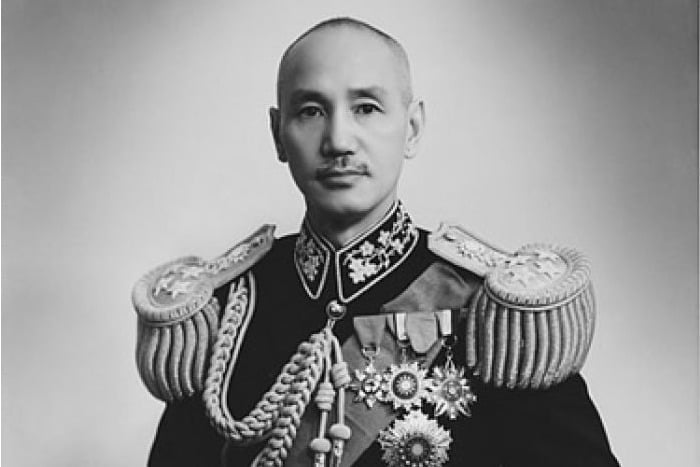 The 1925-27 Chinese revolution was another moment in history when workers attempted to take their destiny into their own hands. The reasons for its failure were analysed in detail by Leon Trotsky, (See Leon Trotsky’s Collected Writings On China). The defeat of the revolution, again, led to a terrible bloodbath with tens of thousands of communist workers being killed.
The 1925-27 Chinese revolution was another moment in history when workers attempted to take their destiny into their own hands. The reasons for its failure were analysed in detail by Leon Trotsky, (See Leon Trotsky’s Collected Writings On China). The defeat of the revolution, again, led to a terrible bloodbath with tens of thousands of communist workers being killed.
Throughout 1927 and 1928 a series of massacres took place, the first in Shanghai in March/April 1927. Thousands of activists were massacred. In May the Kuomintang carried out another massacre in Changsha, when some 10,000 communists were killed. Between April and December 1927, it is estimated that 38,000 people were executed and many more were imprisoned. Between January and August 1928, over 27,000 were sentenced to death. By 1930, the Chinese Communist Party had estimated that around 140,000 had been murdered or had died while in prison. And in 1931, a further 38,000 were executed.
In his “The Tragedy of the Chinese Revolution”, written in 1938, Harold R. Isaacs gives the following information on the numbers killed:
“No one knows how many have died under the scourge of Kuomintang terror. No one knows how many men and women, boys and girls, have been mutilated, tortured, imprisoned, and killed during the past decade of Kuomintang rule. It is known only that there have been thousands, scores of thousands, slaughtered and maimed during mass butcheries in the countryside and in the cities, in addition to the victims of the day-to-day manhunts carried on unremittingly, year after year. No one has ever known exactly how many political prisoners choked in stinking jails from one end of the land to the other, or how many of them died of disease or on the rack.
“For the record there are only partial estimates and incomplete figures culled from official announcements and from the daily Press. From April to December, 1927, according to one investigation, there were 37,985 known dead and 32,316 known political prisoners. Between January and August, 1928, 27,699 were formally condemned to death and more than 17,000 were imprisoned. At the end of 1930 the Chinese Red Aid estimated that a total of 140,000 had been killed or died in prison. In 1931 a study of available figures for cities of six provinces established that 38,778 had been executed as enemies of the regime. From 1932 to 1936 the thousands who were killed or filled the prisons were mainly those who in one way or another challenged the contemptible capitulation of Chiang Kai-shek and the Kuomintang to Japanese imperialism, or who tried to organize resistance to the imperialist invasion of Chinese territory, the seizure of Manchuria and a part of North China. Chiang Kai-shek adopted a policy of “non-resistance” to the imperialist invasion while he conducted a merciless war of extermination against insurgent peasants in Central China, killing thousands and laying waste villages and fields in the provinces south of the Yangtze.” (Chapter XVIII. Fruits of Defeat)
What methods did Chiang’s forces use in crushing the Communists? The French writer André Malraux wrote his novel, Man’s Estate (La condition humaine), based on his knowledge of the Chinese Revolution and the bloody aftermath in 1927. In the final part of the book he describes a scene where Communists have been gathered ready for execution:
“In the great hall of the prison… two hundred wounded Communists waited for someone to come and finish them off… They all lay flat on the floor. Many groaned, and there was an extraordinary regularity about their groaning.”
Two of the main characters in the book, Communists, Katow, a Russian, and Kyo, a Chinese, end up in the prison only to discover that this is where they keep the prisoners before torturing them and one of the other prisoners informs Katow that, “They don’t shoot them, they fling them alive into the furnace of the locomotive… Then that’s that – they blow the whistle…”
The prisoners are left there awaiting their fate, watching as groups of prisoners are taken out and shortly afterwards they hear the whistle. Although this is a novel, it portrays graphically the brutality of Chiang’s forces.
All this was done with the backing of all the imperialist powers, from the US to the British to the French. Again, both the western imperialist and the local landlords and bourgeois saw all this killing as a necessity to maintain their rule over the Chinese masses.
The role of Stalin
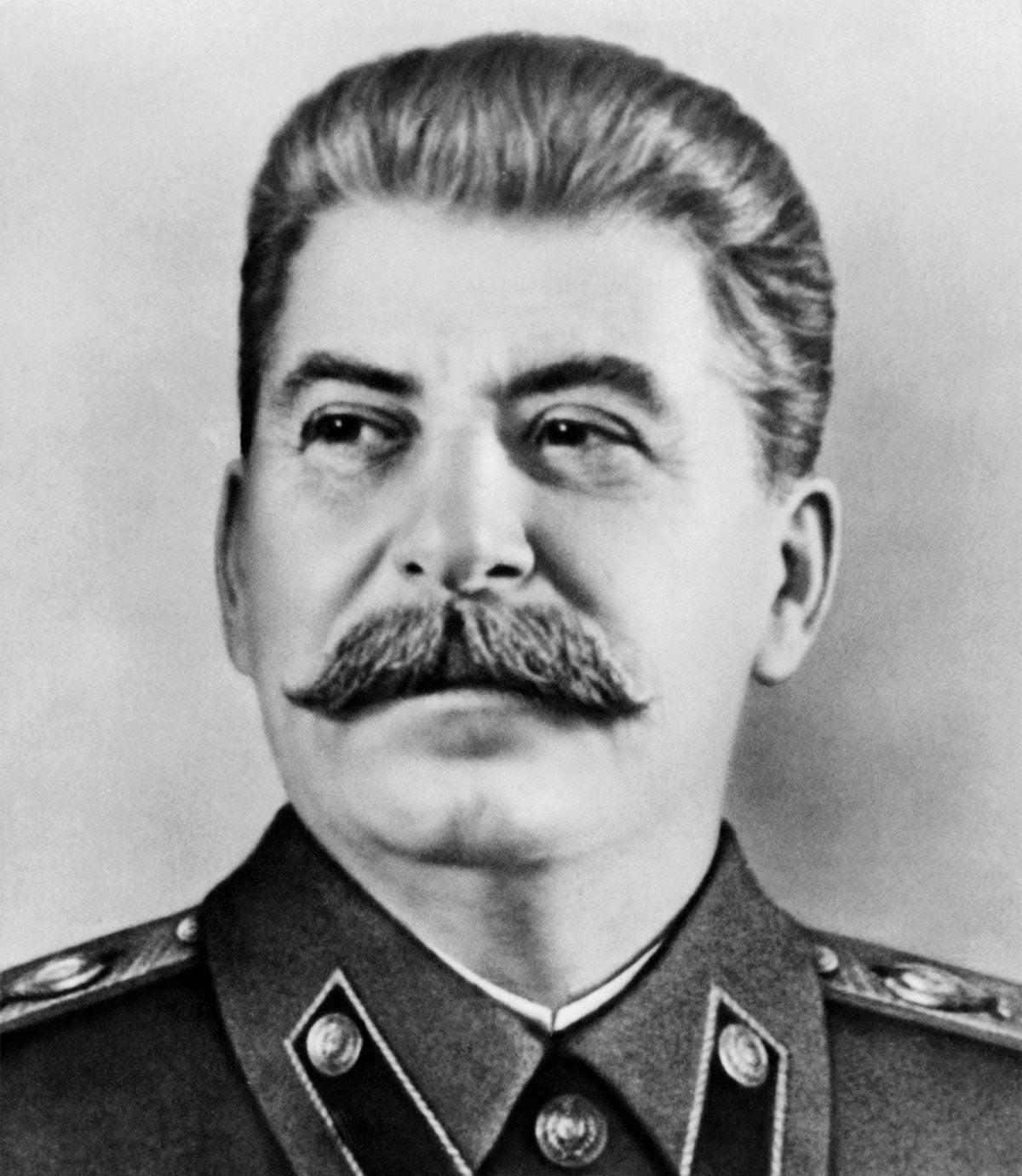 The defeat of the Chinese Revolution was made even worse by the confusion generated among the Chinese communists because of the mistakes and betrayals of the Communist International leadership under the rising influence of Stalin. It is worth noting here what the position of Stalin had been towards Chiang Kai Shek. Chiang’s party, the Kuomintang was accepted as a sympathising section of the Communist International early in 1926 – barely one year before Chiang would organise a bloodbath of Chinese communists – and this decision was later approved by the Politburo of the Communist Party of the Soviet Union (CPSU). The sole dissenting voice was that of Leon Trotsky who voted against. The Kuomintang was even allowed to send “fraternal delegates” to meetings of the Executive Committee of the Communist International (ECCI).
The defeat of the Chinese Revolution was made even worse by the confusion generated among the Chinese communists because of the mistakes and betrayals of the Communist International leadership under the rising influence of Stalin. It is worth noting here what the position of Stalin had been towards Chiang Kai Shek. Chiang’s party, the Kuomintang was accepted as a sympathising section of the Communist International early in 1926 – barely one year before Chiang would organise a bloodbath of Chinese communists – and this decision was later approved by the Politburo of the Communist Party of the Soviet Union (CPSU). The sole dissenting voice was that of Leon Trotsky who voted against. The Kuomintang was even allowed to send “fraternal delegates” to meetings of the Executive Committee of the Communist International (ECCI).
This explains why even in 1927 just prior to the beginning of the massacres, the workers of Shanghai were told that the entry of Chiang’s armed forces marked the hour of liberation! Welcoming parties were even organised for the Kuomintang forces. This was also reflected in the press of various Communist Parties. This is how Harold R. Isaacs describes the situation:
“A few days before the insurrection Rote Fahne, central organ of the German Communist Party, featured a photo of Chiang Kai-shek, describing him as the heroic leader of the ‘revolutionary war council’ of the Kuomintang. (Rote Fahne, Berlin, March 17, 1927.) A similar photo appeared in L’Humanité, French Communist daily, on March 23, with a report of a great mass meeting at which Chiang’s entry into Shanghai was greeted as the inauguration of ‘the Chinese Commune,’ opening ‘a new stage in world revolution.’ An editorial spoke of the Cantonese victory as the ‘liberation of Shanghai,’ which meant ‘the beginning of liberation for the workers of the world.’ (L’Humanité, March 23, 1927)”
Thus, in the killings that followed the defeat of the 1925-27 Chinese Revolution, the Stalinists hold heavy responsibility, as they created the illusion that Chiang was a “saviour”, thus politically disarming the Chinese workers and leaving them unprepared for what was about to happen.
Japan invades but Chiang’s priority is to destroy the Communists
Much has been said about the millions that died in the fighting over many years in China, but the responsibility for this lies with the Chinese capitalists and landlords and the imperialists whose interests they served. They were not prepared to give up their land and their profits. The Chinese bourgeois considered it more important to fight the Communists than the invading Japanese. This was shown repeatedly during the Japanese invasion. This is not the first time in history that we have seen a ruling class having more in common with the enemy invaders than with their own people!
After consolidating his grip on power in 1927, Chiang concentrated his attention on exterminating the Communists. This marked the origin of what was later to be known as the Long March, as the Communists fled the cities and reorganised as a guerrilla army in remote areas. Within a few years, in 1931, the Japanese invaded China, taking Manchuria, and then deployed troops in Central China in the province close to Beijing. Instead of concentrating his forces against the Japanese, Chiang positioned the bulk of his forces near Yenan, as his main objective was to destroy the Communist forces.
In his book “Tea That Burns: A Family Memoir of Chinatown”, Bruce Hall points out the brutal methods used by the advancing Japanese forces:
“In July of 1937, the Japanese invade and occupy Peking, Shanghai and Tianjin, while in Nanking they engage in an orgy of violence that shocks the entire world. In a period of only six to eight weeks some 300,000 of Nanking’s civilian residents are slaughtered by methods of appalling cruelty. Japanese soldiers stage beheading contests, people are flayed alive. Others are hanged by their tongues, and children are tortured to death with needles. In addition, an estimated 20,000 women are raped—many by their own fathers or sons at the point of Japanese bayonets—before the entire families are murdered and their bodies mutilated. And all this without a fight from Chiang Kai-shek’s army. Which he mysteriously deems too ill-equipped even to attempt to stop his Japanese foe.” (page 215) [My emphasis]
As we can see, there was a de facto alliance between Chiang and the Japanese imperialists, for the propertied class that Chiang represented had more in common with the Japanese capitalists than with Chinese workers and peasants.

